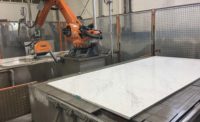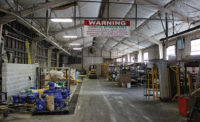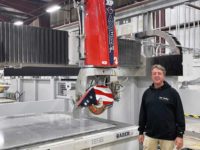Robotic technology is one of the newest options out there for fabricators to cut stone and since its introduction the saw has continued to gain in popularity. Known for their smaller footprint, efficiency and less maintenance needed, as the worker shortage continues for fabricators, turning to this technology has been a great alternative to increase performance in the production process.
HOW IT HAS ADVANCED THE INDUSTRY
Throughout different industries across the U.S., there have been labor shortages, especially of skilled employees. As technology continues to evolve, it looks to fill in the gaps of those labor shortages. According to Tony Herbst, the director of sales for Park Industries, robotic technology is immerging in a variety of industries due to labor shortages and a focus on manufacturing efficiency. “New technology is always exciting,” said Herbst. “Some advantages to the robotic sawjet technology on the market today are primarily the lower maintenance costs, the potential for floor space conservation and the overall aesthetics of a robot in a fabricator’s shop. As our industry continues to evolve, and become less dependent on labor, the sawjet in general has become more critical to a fabricator’s operation. Robotic sawjets do have their limitations, but they have come a long way.”
According to Scot Lindemann, president of BACA Systems, the technology of all robot manufacturers across all industries is continuously advancing. “When robots are introduced into a new industry, they are quickly accepted and have historically improved manufacturing industries based on mass-produced technology from global robotic manufacturers, end users of robotic systems benefit from the advancements in not only technology, but most importantly, reliability,” he said. “With over 350 robotic systems in the stone industry, BACA works closely with KUKA Robotics to continuously apply new robotic technology and software to improve fabrication processes in the stone industry. BACA’s software has become more intuitive for the end user, easy-to-use software is key to allow a fabricator with a limited labor pool to operate a robotic system just as easily as a smart phone.”
THE FUTURE OF ROBOTIC TECHNOLOGY
While the technology and capabilities of robotics continuously changed and expanded, the technology for the stone industry is still developing. The technology is just in the infancy stage of what a digital transformation can do to an industry. Past examples are when money changed to credit cards that changed to Apple or Google Pay. That’s just one example on one industry changes on bring digital. Printing is another. Newspaper, color magazines, to computers to everything is now in your pocket. All these things changed when they went digital. What will be the outcome of the digital transformation of the industry is just starting? We don’t know yet but it’s exciting to think about the possibilities.
“There is another point to be made about robots,” Lindemann went onto say. “Every robot integration isn’t the same for every company, it’s not a one-size fits all. Robots come in different sizes, payloads, reaches, etc. The goal for any machine should be to enhance the fabricators profitability, safety and production increase. The BACA Robo SawJet accomplishes all of goals and more. Our 30 years of experience that we have brought to the stone industry has made these significant strides for our customers in the past five years. As the digital process is driving the stone industry forward, robotics has been key to customer success. As fabricators become more reliant on equipment operating every day to meet their own customers’ time deadlines, the reliability of robots have proven to exceed our customers’ expectations compared to traditional gantry equipment. I would say to fabricators to do your homework and make sure to choose equipment that has the lowest total cost of ownership (TCO) and is solution that can really improve your shop.”
Daniele Francolini, brand sales manager – stone division of Intermac, agrees with Herbst and Lindemann that robotic technology is the way of the future. He explained that when Intermac works on its research and development, it considers two primary targets: customer care and automation. “We do have experience with automation,” he said. “Robots can be associated with many things – not only sawjets, but handling systems too.”
Francolini went on to say that the Biesse Group has been using the Italian manufacturer’s robotic equipment for a while now, and the company believes it is time to introduce a slab handling system to the stone industry. “It’s the complete factory for us,” he said. “The automatic storage system is the next step. Safety is a big feature. There is a fencing system around it.”
A benefit of storage systems is that they can save on space in a shop. Features such as side-shift drawers represent the ideal solution for storing huge quantities of slabs in the smallest space as possible and electrical movement of the frames allows for slabs to be quickly and easily reached when needed in a completely safe environment for the operator, according to Intermac.
“We are focusing on a new brand of the market,” said Francolini. “Fabricators are working with porcelain slabs now. It is important to follow the market trends and listen to the needs of our customers.”
In recent years in the stone industry, robotic technology has made huge evolutionary strides and there is no reason to assume those strides won’t continue as fabricators continue to face a variety of challenges to tackle. “Robotic technology in the stone industry will continue to evolve to address stone fabrication pain points, including material handling, labor constraints and overall shop efficiencies,” said Herbst. “As more and more robots are installed and the technology advances, it will give fabricators a stronger market sampling of what best fits their needs.”
“All industries that have had the opportunity to apply a robotic-based solution with process capability and the ability to meet the performance requirement, have rapidly moved to robot-based solutions,” said Lindemann. “It has been our experience that it requires an extensive knowledge in this industry to achieve maximum benefits for fabricators. Otherwise it’s just a cool robot.”








